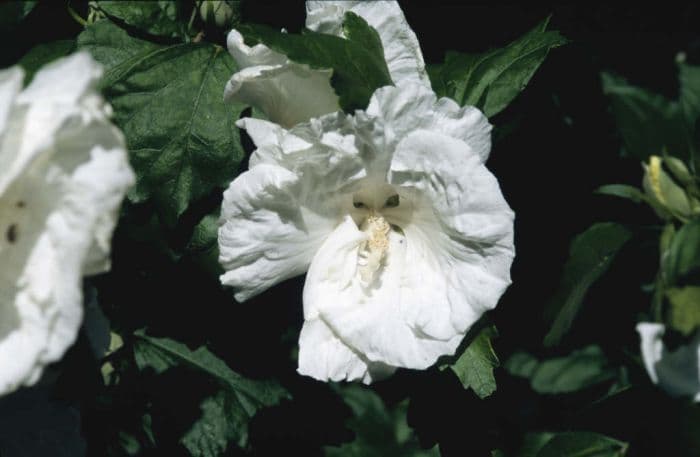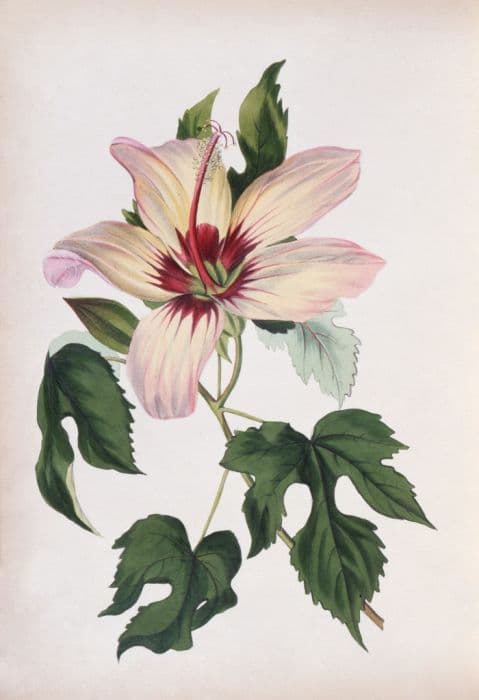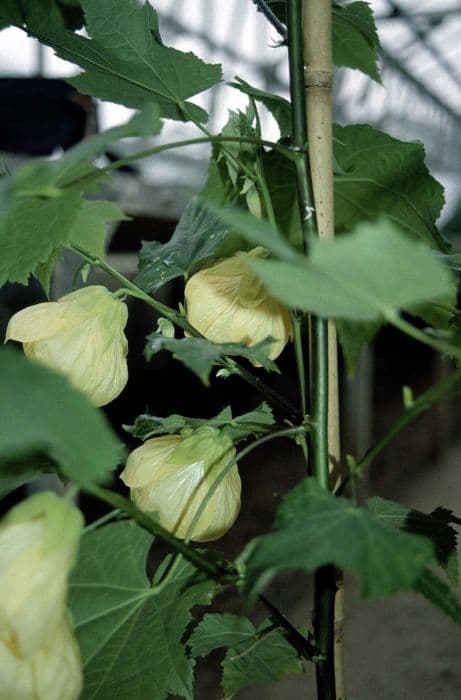Rose of Sharon Hibiscus syriacus 'Diana'

ABOUT
The Hibiscus syriacus 'Diana', commonly known as the Rose of Sharon 'Diana', is an attractive flowering shrub renowned for its showy blooms. The plant's flowers are a distinguishing feature, characterized by their large, white petals that present a crisp and pure coloration. These blooms are known for their trumpet shape, which adds an elegant and distinctive look to the plant. The foliage of the Rose of Sharon 'Diana' consists of medium to dark green leaves that offer a lush background for the bright flowers. These leaves are typically broad and have a smooth texture with a slight glossiness to them, creating a striking contrast against the plant's striking blossoms. Moreover, the Rose of Sharon 'Diana' has a bushy, upright growth habit that contributes to its graceful presence in a garden setting. Throughout its blooming season, which usually spans from summer into fall, the plant becomes a hub of activity for pollinators like bees and butterflies. In addition to its white flowers, which can have a slightly ruffled look, residents and gardeners may also notice the plant's prominent and showy stamens that stand out in the center of the bloom, often adding a touch of drama to the visual display. This variety of the Rose of Sharon maintains its elegance throughout the blooming season, and its individual blossoms typically have a long-lasting quality that extends their decorative appeal. Even when not in bloom, the foliage alone gives the plant an attractive and robust presence within a garden or landscape design.
About this plant
 Names
NamesFamily
Malvaceae
Synonyms
Rose Of Sharon, Shrub Althea, Hardy Hibiscus
Common names
Hibiscus syriacus 'Diana'.
 Toxicity
ToxicityTo humans
Rose of Sharon is not known to be toxic to humans. It does not typically cause poisoning or adverse symptoms if ingested in small quantities. However, as with any plant material, individual allergies or sensitivities are possible, and ingesting large amounts could potentially cause stomach discomfort or nausea due to the plant's fibrous content.
To pets
Rose of Sharon is considered to have low toxicity to pets. However, it may cause some mild gastrointestinal upset, such as vomiting or diarrhea, if ingested in large quantities. Generally, this plant is not associated with severe poisoning or long-term consequences for pets, but pet owners should still prevent their animals from consuming the plant to avoid any potential discomfort.
 Characteristics
CharacteristicsLife cycle
Perennials
Foliage type
Deciduous
Color of leaves
Green
Flower color
White
Height
8-12 feet (2.4-3.7 meters)
Spread
6-10 feet (1.8-3 meters)
Plant type
Shrub
Hardiness zones
5-8
Native area
Asia
Benefits
 General Benefits
General Benefits- Ornamental Value: The large, showy white flowers of the 'Diana' hibiscus make it a beautiful addition to any garden or landscape.
- Attracts Pollinators: 'Diana' serves as a nectar source, attracting butterflies and other beneficial insects.
- Drought Tolerance: Once established, it can tolerate periods of drought, making it suitable for xeriscaping and low-water gardens.
- Low Maintenance: It requires minimal care once established, needing only occasional pruning and fertilization.
- Privacy Screen: Can be used as a hedge or privacy screen due to its dense foliage.
- Seasonal Interest: Provides late summer bloom when many other plants have finished blooming.
 Medical Properties
Medical Properties- Antioxidant properties: Hibiscus syriacus 'Diana' may contain antioxidants that help protect cells from damage.
- Anti-inflammatory effects: The plant could potentially have anti-inflammatory properties used to reduce swelling and inflammation.
- Mucilage content: Hibiscus syriacus 'Diana' may have mucilage that is used to soothe irritated mucous membranes.
- Diuretic activity: Some parts of the plant might act as a diuretic, helping with the removal of excess fluids from the body.
 Air-purifying Qualities
Air-purifying QualitiesThis plant is not specifically known for air purifying qualities.
 Other Uses
Other Uses- As a natural dye: The flowers of the Rose of Sharon can be used to make natural dyes for fabrics, offering colors ranging from light pink to deep purple, depending on the mordant used.
- For creating jewelry: The petals of Rose of Sharon can be preserved in resin to make unique, floral-themed jewelry pieces like earrings and pendants.
- Paper making: The fibers from Rose of Sharon's bark and stems can be used as a component in handmade paper, giving it a distinctive texture and finish.
- Fiber art: Artists may incorporate dried parts of Rose of Sharon into weavings or textile artworks to add natural elements and textures.
- Instruments: The wood of Rose of Sharon can be utilized in crafting musical instruments like flutes, due to its fine grain and workability.
- Culinary garnish: The flowers can be used to decorate cakes or as a colorful addition to salads, being both edible and having a mild flavor.
- Photography: The blossoms provide an excellent subject for macro photography, allowing photographers to explore details such as texture and color variation.
- Art supplies: Petals and leaves can be used to make eco-friendly inks and watercolors, appreciated for their unique hues and environmental sustainability.
- Education: The plant can be used in biology classes to teach about pollination and plant reproduction, as it is an attractive host for pollinators.
- Wildlife habitat enhancement: Planting Rose of Sharon in gardens can help provide shelter and food for birds and beneficial insects.
Interesting Facts
 Feng Shui
Feng ShuiThe Rose of Sharon is not used in Feng Shui practice.
 Zodiac Sign Compitability
Zodiac Sign CompitabilityThe Rose of Sharon is not used in astrology practice.
 Plant Symbolism
Plant Symbolism- Beauty: The Hibiscus syriacus 'Diana', commonly known as Rose of Sharon, has large, showy flowers that symbolize both inner and outer beauty.
- Love: Its eye-catching blooms often represent love and affection, making it a popular plant in romantic contexts.
- Hope: As it can bloom even in harsh conditions, the Rose of Sharon is a symbol of hope, resilience, and the ability to flourish despite challenges.
- Femininity: The delicate nature of its flowers is frequently associated with femininity and celebrated in cultures that link plants with gender expression.
- Renewal: Because the plant can produce new growth after being cut back, it is also a symbol of renewal and rebirth.
 Water
WaterRose of Sharon requires moderate watering, especially during dry spells. It's best to water deeply once a week, providing about 1-2 gallons per plant, depending on the size and weather conditions. Always allow the soil to dry out slightly between waterings to prevent root rot. Water the plant at the base to avoid wetting the foliage, which can lead to fungal diseases. In hot, dry conditions, you may need to water more frequently, but overwatering can be as harmful as under-watering.
 Light
LightRose of Sharon thrives in full sun to partial shade. For optimal growth and bloom, plant it in a location where it can receive at least six hours of direct sunlight each day. While it can tolerate some light shade, too much shade may reduce flowering and cause the plant to become leggy as it reaches for more light.
 Temperature
TemperatureRose of Sharon is hardy and can withstand a range of temperatures, typically thriving in regions with temperatures between 60°F to 90°F. It can survive winter cold down to about -20°F but may need protection in zones with colder extremes. The ideal growing conditions for Rose of Sharon include warm, temperate climates where it can receive plenty of sunlight and heat.
 Pruning
PruningPrune Rose of Sharon to maintain shape and encourage next season's blooms, as it flowers on new wood. Prune in late winter or early spring before new growth begins. This is also a good time to remove any dead, damaged, or crossing branches. Typically, pruning once per year is sufficient, but you can also prune lightly after the flowering period to shape the plant or control its size.
 Cleaning
CleaningAs needed
 Soil
SoilThe Rose of Sharon 'Diana' thrives in well-draining, loamy soil with a pH between 5.5 and 7.5. The best soil mix includes garden soil, compost, and perlite or sand to improve drainage. Mulching is beneficial to maintain soil moisture.
 Repotting
RepottingRose of Sharon 'Diana' is typically grown as a shrub in the garden and does not require repotting. If grown in a container, repot every 2-3 years to ensure adequate space for root growth.
 Humidity & Misting
Humidity & MistingRose of Sharon 'Diana' prefers moderate humidity levels but is adaptable to a range of conditions. It does not require any special humidity considerations when planted outdoors.
 Suitable locations
Suitable locationsIndoor
Place Rose of Sharon 'Diana' in bright, indirect light indoors.
Outdoor
Plant Rose of Sharon 'Diana' in full sun to partial shade.
Hardiness zone
5-9 USDA
 Life cycle
Life cycleThe Rose of Sharon 'Diana' begins its life cycle when a seed germinates, typically in spring, after experiencing a period of cold stratification to break dormancy. The seedling stage follows, where the plant develops its first true leaves and establishes a basic root system. As it enters the vegetative stage, the plant grows rapidly, producing stems, leaves, and branches, which allows it to photosynthesize more efficiently and garner resources for blooming. Flowering occurs in the summer to early fall, where 'Diana' boasts large white flowers that are attractive to pollinators, leading to cross-pollination if there are viable mates nearby. After pollination, the plant sets seeds enclosed in capsules, which mature and are eventually dispersed to close the reproduction cycle. The Rose of Sharon 'Diana' is a perennial shrub, repeating this cycle each year while gradually increasing in size and capacity to produce more flowers and seeds.
 Propogation
PropogationPropogation time
Spring-Summer
The Rose of Sharon 'Diana' can be propagated through softwood cuttings taken in late spring or early summer. To propagate by cuttings, a healthy stem tip about 5 to 6 inches (roughly 12.7 to 15.2 centimeters) long is selected. Leaves are removed from the lower half of the cutting, and the cut end is dipped in a rooting hormone to enhance root development. The cutting is then placed in a well-draining potting mix, with the leafless portion buried. It's important to maintain a humid environment for the cutting by covering it with a plastic bag or placing it in a propagator, but one should ensure that the plastic doesn't touch the leaves to prevent fungal issues. The pot is kept in a bright, indirect light location until roots develop, usually within a few weeks, after which it can be gradually acclimatized to outdoor conditions.









